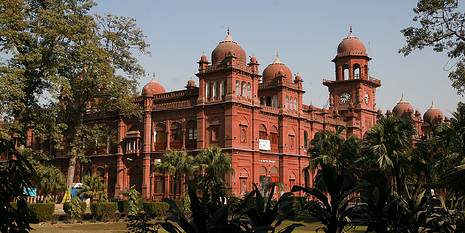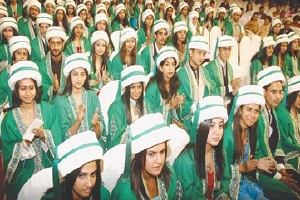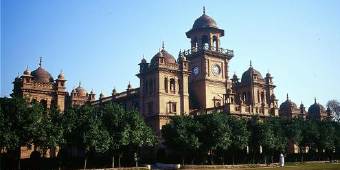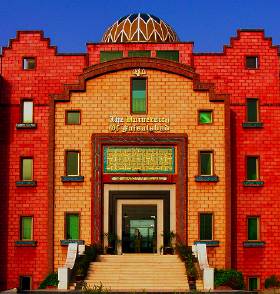Junaid Siddiqui
Last year at ATP, there was a post on the HEC (Higher Education Commission)’s Ranking of Pakistani Universities. That single post generated so much interest that in the past one year it has got 30000 hits on it. It not only shows the immense interest among prospective university students but also shows lack of career counseling or guidance available to them.

I have written this article in a hope of building further on HEC’s rankings as well as to show that Pakistani universities have very far to go to make up to any internationally recognized University Ranking.
 Spanish National Research Council biannually publishes Webometrics Ranking of World Universities. The raking is based on data obtained from popular search engines. Universities for this purpose are identified based on their institutional web domains. The methodology of ranking is based on the following quantitative indicators:
Spanish National Research Council biannually publishes Webometrics Ranking of World Universities. The raking is based on data obtained from popular search engines. Universities for this purpose are identified based on their institutional web domains. The methodology of ranking is based on the following quantitative indicators:
Size (S). Number of pages from a university’s domain recovered from search engines.
Visibility (V). The total number of unique external links received (inlinks) by a university’s site.
Rich Files (R). Number of rich files available on a university’s domain recovered from search engines. The file types considered include Adobe Acrobat (.pdf), PostScript (.ps), Microsoft Word (.doc) and Microsoft Powerpoint (.ppt). This is considered as it is relevant to academic and publication activities of a university.
Scholar (Sc). Number of papers and citations for a university’s domain available on Google Scholar.
Following formula is used to rank universities:
Webometrics Rank (position)= 4*RankV+2*RankS+1*RankR+1*RankSc
 The ranking criteria is quantitative is nature for which data can be easily obtained through some simple search engine queries. What is, however, interesting to note about the ranking results (last published in July 2007) is that they compare rather well with other world rankings of universities such as the Shanghai Jiao Tong University ranking or The Times World University Rankings.
The ranking criteria is quantitative is nature for which data can be easily obtained through some simple search engine queries. What is, however, interesting to note about the ranking results (last published in July 2007) is that they compare rather well with other world rankings of universities such as the Shanghai Jiao Tong University ranking or The Times World University Rankings.
SESRTCIC, a research center of OIC, has recently released a preliminary Academic Ranking of Universities in the OIC Countries, which is based on the research output data of the universities of OIC member states. Most of the top ranking Middle Eastern universities in the composite index of OIC ranking are also among the top Middle Eastern universities in the Webometrics ranking. The Webometrics ranking, therefore, seems to be a good indicator of global standing of a university.
Given that Webometrics ranking is based on quantitative parameters we can expect that a populous country like Pakistan should have at least few of its universities, let us say, in the top 2000. However when we look at the Webometrics ranking of Pakistani universities, it is disappointing to see that there are no universities in even top 3000 and there are only two universities in top 4000 rankings. They are Lahore University of Management Sciences (rank 3071), Aga Khan University, Karachi (rank 3422) and the Punjab University, Lahore (rank 4685).
 Universities form the centers of intellectual and scholarly activities in any country and the Webometrics ranking of our universities is an indicator of the dismal situation we have in our country. Interestingly the two universities in top 4000 (LUMS and AKU) are the same universities that Dr. Pervez Hoodbhoy identified as the two Pakistani universities closest to the universities located in free societies across the world.
Universities form the centers of intellectual and scholarly activities in any country and the Webometrics ranking of our universities is an indicator of the dismal situation we have in our country. Interestingly the two universities in top 4000 (LUMS and AKU) are the same universities that Dr. Pervez Hoodbhoy identified as the two Pakistani universities closest to the universities located in free societies across the world.
Independent thought is the foundation that allows intellectual activities to flourish which seems to be missing from the fabric of most of our higher education institutions. The recent article on BBCUrdu.com about the kind of thoughts promoted at our long established Karachi University is one example of what is happening at our universities.
Whether it be the education in the disciplines of natural sciences or social sciences the situation is the same. When we go into the classrooms what we find is an environment that restricts the thinking of our students than opening it up. This is yet another aspect of our society which needs immediate and radical measures.
About the Author: Junaid Siddiqui is a Civil Engineering graduate of NED University Karachi and now a lecturer at King Fahad University of Petroleum and Minerals.




















































I wonder what the Pakistani Universities ranking will be if the criteria includes accomplishments of its graduates, including research publications, who now have faculty positions at other universities in the West and the Middle East.
I also hope that alumni of the Pakistani Universities, most of whom got almost free education at these universities can share some of their experience and wealth to support the institutions. My experience is that most of alumni of Pakistani universities do not want to donate a single penny to their alma mater. IIT alumni recently held a fund raiser in Washington DC for their alma mater and raised more than a million dollrars. I have been trying a similar effort for UET and have so far received less than ten thousand dollars over a nine month period. The alumni do not even want to become members even at no cost. They want to know what is in it for them.
Web presence of universities is a subject on which I have been wanting about doing an ATP post but have not been able to get to it. Thanks to Junaid for bringing it up.
When I was doing my undergrad at a univ in Islamabad, one major problem we had was that the university management was not very serious in ensuring quality. Some of the instructors would not even bother to sit down at the beginning of the semester to plan the course and the management did not feel troubled by it. There were times when I knew that an instructor was not doing a good job, but I could not refer the administration to a syllabus and point out what was being left out because none was available. If universities are required to have a website for every course containing the syllabus, it can also help in improving the quality of teaching, because then the students have a document they can refer to and then they will know what a course is supposed to be about. This will influence their evaluations of the teachers at the end of the semester and put more pressure on the administration to keep an eye on quality.
Another important one is the suggestion by Owais that the final year projects should be digitized. That way, people can go on-line and look at some projects to get an idea about the quality of a university on their own rather than just relying on HEC rankings or widely held perceptions, which may not always be fair. A university whose graduates struggle to put together a grammatically correct paragraph will clearly stand exposed this way. A final year project should be a requirement for every 4-year bachelers degree or an equivalent masters one in every field, whether its physics, engineering, urdu literature or Islamiat. This alone can go a long way in bringing some transparency and improving the quality of teaching.
I also feel that all universities should be required by HEC to maintain webpages for all their faculty members and these should contain their resumes, list of research publications (with URLs to them if available), course being taught (with links to the course websites as mentioned earlier) and other info like whether they are in a position to take on additional students for PhD or undergrad research. This will really help perspective students, especially those looking for a PhD supervisor.
I feel that in the emphasis on the bigger goal of improving the faculty by providing scholarships and other incentives, this relatively smaller issue of using the internet to bring transparency is being ignored at a huge cost. We can not get all universities to have world class faculty in such a short period of time (even India has only 15-20 or so good ones and the rest are fairly ordinary), but at least such measures for transparency can bring some pressure on the really bad ones to get some basics in order.
PS: Someone said that digitizing of the project reports is not necessary and scanned images can be posted. I disagree. These days, all projects are typed up on the computer anyway so might as well post the digitized version. It may not be important for most of you, but a blind person can read the digitized version independently through a screen reader software (subject to some issues about the format) but images are not accessible. We need to make our education system inclusive to everyone and that should include people with disabilities.
I would disagree that cutting the military budget is the major part of the solution for our higher education problem. Infact a good part of the research produced in Pakistan is apparently in the military sector by Atomic Energy Commision and KRL etc.
I agree with Junaid bhai that the primary step is increasing the activity level at the university as Junaid Bhai said, and for that there are no shortcuts. Our universities must be attractive enough that atleast masters student stay in Pakistan if not pHd, because its the graduate students who produces mass research anywhere in the world. Second is a short term approach which is to make the universities aware of such norms in the world. I visited NED after about 4 years when I was in Pakistan few weeks ago and I must say that the graph of infrasturture is definitely uphill. May not be as steep as we would like but not at all a hopeless situation. Infact the library has improved a lot and there is a third floor coming up. As Owais bhai said, among other improvements, only if universities start digitizing the final year projects and presenting it in a structured format on its website will not only increase the web foot print of Pakistani universities but also gives a good idea of activity level in university for self evaluation. Infact universities even do not need to digitize the projects, they simply need to link the soft copy of the submitted project to a structured website of university library. Another way is to give student a university webspace. Even 50 mb will do wher students can publish their term assignments. Its good to share stuff anyway.
BTW, Taj mahal shouldn’t be taken negatively. I am sure I can publish couple of papers on Taj Mahals socio economic impacts and environmental performance ;)
Owais I agree that several simple steps can be taken to improve web presence of our universities. Realizing the value of open access to thoughts and idea and the free flow of ideas is yet another factor that makes a difference. Just look at the impact a single Blog like ATP has made. ATP has a web presence comparable to LUMS.
Pages in Yahoo at the moment
LUMS: 10, 800
http://siteexplorer.search.yahoo.com/search?p=http %3A%2F%2Flums.edu.pk&bwm=p&bwms=p&fr2=seo-rd-se
ATP: 11,300
http://siteexplorer.search.yahoo.com/search?p=http %3A%2F%2Fpakistaniat.com&bwm=p&bwms=p&fr2=seo-rd-s e
External Inlinks at the moment
LUMS: 2850
http://siteexplorer.search.yahoo.com/advsearch?p=h ttp%3A%2F%2Flums.edu.pk&bwm=i&bwmo=d&bwmf=s
ATP: 15,800
http://siteexplorer.search.yahoo.com/advsearch?p=h ttp%3A%2F%2Fpakistaniat.com&bwm=i&bwmo=d&bwmf=s
Add some blogs to the culture of any university and it can have great impact in every sense.
Very good article; I’m always very interested in articles about higher education in Pakistan. And certainly, with the likes of Adil Najam, etc we have writers of authority.
Anyway, it’s hard to admit, but India is doing much better in higher education than Pakistan. Think about it, if Pakistan just had two PITs based on the model of IITs in India (which are in turn based on MIT, arguably the most elite technical school in the world). These schools have completely different organizational structures, with almost not interference from government, and they have nation-wide admissions exams.
The Aga Khan Medical College produces batch upon batch of extremely talented physicians who land residencies in the most elite residency programs in the world including at Mass General, Hopkins, Mayo Clinic, etc. There is no reason why we cannot have a technical school of similar caliber….who knows, maybe the LUMS SSE project will do that for Pakistan….I sure hope so, hopefully I can get a faculty position there when I graduate :-).